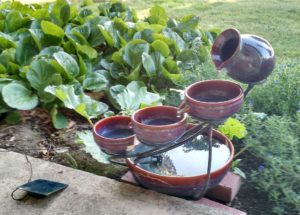Solar in Seattle? Not So Fast (clouds, clouds, my Dear Watson)
By Greg Rehmke -- July 13, 2017“Seattle tops the list with 226 days of heavy clouds each year, or about 62%. Portland is next with 222 days of heavy clouds.”
“It rarely gets real hot in western Washington (most houses don’t have or need air conditioners, and only one of my neighbors has one). But that reduces the rationale for solar panels further, since they are best at cutting peak power demand by supplying electricity and absorbing heat of the sun on hot afternoons.”
The new Administration is shifting federal energy policies and that concerns companies, employees, and advocates of solar power. “Sunset for solar incentives? Panel installers worry about industry’s outlook,” Seattle Times, July 1, 2017) quotes one solar CEO on what may be a solar apocalypse for Washington state’s solar industry:
“Solar energy is looking at 2020 as a critical year,” Jeremy Smithson, CEO and founder of Puget Sound Solar, said last week about the scheduled sunset date for state renewable-energy incentive programs designed to make solar more affordable.
Then the Seattle Times article reports on costs and subsidies:
Cost remains the biggest barrier for solar. Weather is not actually a problem, with long summer days providing enough sun to make up for rainy winters. Despite increasingly efficient technology and declining costs, most customers in Washington still rely on state and federal incentives to make the substantial cost of installing solar pencil out.
Is it true that “long summer days” in Washington state “make up for rainy winters” for solar here? It’s true that winter days are shorter and summer days longer at 47.6 north latitude (16 hours of sun on the summer solstice!). But it’s also true that days in spring and fall days as well as winter are also often overcast and rainy.
“Cloudiest Cities in America,” reports:
The west coast cities of Portland and Seattle top the list of cloudiest large cities in the United States.
Overall, nine major American cities have solid overcast for more than 180 days a year. Besides the Pacific Northwest, cities with frequent cloudy weather are mainly near the Great Lakes.
Seattle tops the list with 226 days of heavy clouds each year, or about 62%. Portland is next with 222 days of heavy clouds.
Sperlings “Best Places” Climate overview page for Seattle says:
On average, there are 152 sunny days per year in Seattle, Washington.
The Olympic Rain Shadow website which compares the relatively sunny city of Sequim with Seattle reports for 2010-2011 that Seattle had 88 mostly sunny days, 117 partly sunny days, 137 cloudy days, and 23 “dreary days.” (Sequim, in the shadow of the Olympic mountain range, enjoyed 127, 127, 102, and 9).
Rooftop solar installations in Sequim generate significantly more power than those in Seattle. Unfortunately for the solar installation industry, the population of Sequim is under 7,000 while over 700,000 live in Seattle and 3.8 million in Seattle plus suburbs and nearby cities.
Skeptical of solar power subsidies is “Washington’s Solar Subsidies Cost 13.5 Times The Price Of Power Generated,” (Daily Caller, April 14, 2016):
The Washington Policy Center estimates that the solar subsidies will cost the state government $24.7 million a year by 2020 when the program is scheduled to expire. The state government admits the subsidies program cost $7,980,142 in fiscal year 2015.
The subsidy cash isn’t just coming from the state government, as the program is structured so people can also pick up a 30 percent tax credit from the American federal government.
Consumers benefit as the cost of solar power efficiency increases and the cost of panels continues to drop. But solar installation and maintenance costs remain high and continue to be costly to Washington state and federal taxpayers. At least until 2020.
Still, back to the Seattle Times solar climate claim:
Weather is not actually a problem, with long summer days providing enough sun to make up for rainy winters.
Weather is a problem for those of us irritated by Seattle’s many cloudy, rainy, and sometimes dreary days. We benefit however from Seattle moderate temperature. It rarely gets real hot in western Washington (most houses don’t have or need air conditioners, and only one of my neighbors has one). But that reduces the rationale for solar panels further, since they are best at cutting peak power demand by supplying electricity and absorbing heat of the sun on hot afternoons.
Providing power at periods of peak demand is a huge benefit to electric utilities, since it reduces their peak load and highest-cost electricity.
But again, we don’t have much of those hot, hot afternoons in Seattle. The Best Places link above gives the numbers:
The July high is around 75 degrees. The January low is 37. Sperling’s comfort index for Seattle is a 79 out of 100, where a higher score indicates a more comfortable year-around climate. The US average for the comfort index is 54. Our index is based on the total number of days annually within the comfort range of 70-80 degrees, and we also applied a penalty for days of excessive humidity.
 So, three cheers for solar power in sunny places where can deliver true cost-savings for consumers and electric utilities.
So, three cheers for solar power in sunny places where can deliver true cost-savings for consumers and electric utilities.
My Solar Moment
Here in Seattle I continue to enjoy my solar-powered water fountain. Long summer days benefit this small solar installation. It’s not running this evening even though the sun is shining because of another Seattle solar problem: trees. Lots of lush green trees here. They are wonderful and their shadows shade our homes. But those shadows also stop nearby solar panels from time to time as the sun travels the sky each day.
Here though is picture from another day when the sun was aligned to hit the little solar panel powering the little pump to launch my solar fountain. (Here is a similar model for $89 on Hayneedle.com.)
Take this to its logical conclusion and pretty soon you’ll see advocates placing solar installations in caves!
Seriously, if solar is to have any impact, the GemaSolar installation by Torresol Energy near Seville in Spain, with heliostats focussing on molten salts in an area that gets over 330 cloudless days per year should be used to promote the concept. Seattle/Portland is not quite as bad as the caves, but pretty close, and using taxpayer subsidies to promote this is simply outright theft.
http://www.dailymail.co.uk/news/article-4658696/Large-blaze-brand-new-block-flats-East-London.html
Solar panels do emit carbon and other pollutants in a hurry when things go wrong.
Also, the Seattle Times article was updated to report that state solar subsidies have been extended by the state legislature until 2030.
“Information in this article, originally published July 1, 2017, was updated the same day after the Legislature passed a bill extending the state incentive program to 2030. A previous version said the incentive would expire in 2020.”
http://www.seattletimes.com/business/sunset-for-solar-incentives-panel-installers-worry-about-industrys-outlook/
Greg,
Yes, Seattle has many cloudy days but the clearer days are also the days with the most daylight hours. Who cares if it’s cloudy in December and January (and it is cloudy); there isn’t much sun anyway and what there is doesn’t get very high in the sky.
What matters are the six months grouped between the Equinoxes. According to the Western Regional Climate Center, Seattle has the following breakdown from April through September of clear/partly cloudy days: April 5/9, May 7/11, June 7/8, July 12/10, August 10/10, September 9/8. Clear is defined as zero to 3 tenths average sky cover; partly cloudy is 4 to 7 tenths. These total 50 clear and 56 partly cloudy days during peak production months.
Also, Seattle’s mild temperatures even at the height of summer give it a marked advantage over a sunnier, hotter climate such as Arizona, because heat adversely affects solar PV output. There’s plenty about this on the web, for example: https://www.civicsolar.com/support/installer/articles/how-solar-panel-temperature-affects-efficiency
Finally, you misunderstand the significance of summertime solar production to the Seattle grid. It is correct that solar in the summer does not match peak season (winter) or peak diurnal (evening) demand. However, it does intersect nicely with declining water reserves for the dams (and Seattle is 90% hydro). Snowpack typically reaches its peak around the third week of May and falls off precipitously by early July. http://www.seattle.gov/light/ctracks.html Hence, solar production corresponds with melting snowpack and thus helps preserve water behind the dams. Excess power flows to California via the Pacific Intertie, and serves air conditioning loads there, or in Eastern Washington and Oregon.
There is no doubt that Washington’s production incentives were high. But they were enacted well before the solar boom that saw rapidly falling panel prices. They were also designed to foster in-state inverter and panel production. The law has just been rewritten with lower incentives and with a clear phase out date, which is what you want.
To really understand solar, you need to see an analysis of the total system benefits, not simply compare incentives to retail power costs as Andrew Follett does in the article you linked to. The best work I have seen is by Jim Lazar and his colleagues at the Regulatory Assistance Project (RAP). They discuss how to address the duck curve and create appropriate rate structures for solar PV in elaborate detail.
Regards, Thor Skov
I think that a dam might be also beneficial in Seattle since the number rainy days are on par with the sunny days.
It is only a matter of time before we see solar powered fans pointed at wind powered lights pointed at solar powered etc.
A near perfect image illustrating the sort of circular reasoning used to justify this unbaked technology. Instead of deriving the conclusion from the premise, any justification merely restates the premise as the conclusion. Indeed, in renewables world, the premise relies on the assumption of the conclusion, always begging the question.
In reality, solar in Seattle has about a 5 percent capacity factor over a five year duration, given the region’s relentless drizzle and, not least, summer’s bug guts that take so much angular momentum away from photonic activity. Any “system wide benefits” pale compared to the general dysfunction created by the way many thousands of solar rooftops, when they do actually generate electrical energy, produce variable output (not modern power) that must be balanced by proactive conventional generation–at everyone else’s expense. Grid solar is a hopelessly uncivil enterprise.
Solar and wind “technologies” are companions much in the way Huck Finn’s Duke and Dauphin are companions, both con artists conducting a number of increasingly disturbing swindles while their victims remain at their mercy-even as they realize the fraud. The former are empowered by the near immortal Congressional subsidies, which continue to indemnify their perfidy.
Solar does not produce electricity from heat as the article describes. Heat actually reduces the efficiency of solar panels. Please do your research before writing about it.
[…] Solar in Seattle? Not So Fast (clouds, clouds, my Dear Watson), (MasterResource, July 13, […]
“Indeed, in renewables world, the premise relies on the assumption of the conclusion, always begging the question.”
Are you suggesting understanding a cycle requires circular reasoning? Because… it doesn’t.
Otherwise you have a lot of interesting stories about what may impact the performance of solar cells, but not a lot of math. The scientists and engineers working on energy solutions do a lot of math, understand entropy and the like. The technology isn’t bunk, even if some people wish perpetual motion motion machines exist. Those people are as cringe-worthy to those who do understand the more advanced concepts to as they are to those who do not.
Luddites = anti-solar, lol.
I love how solar panel prices are dropping but their efficiency is going up. A ton of people might not understand why this is the case but I am okay with it. As long as I can get my solar panels one day.